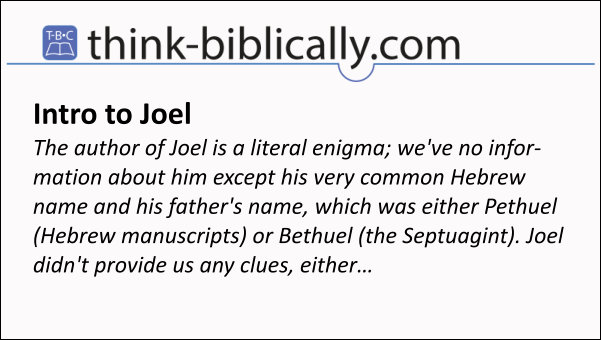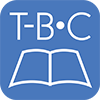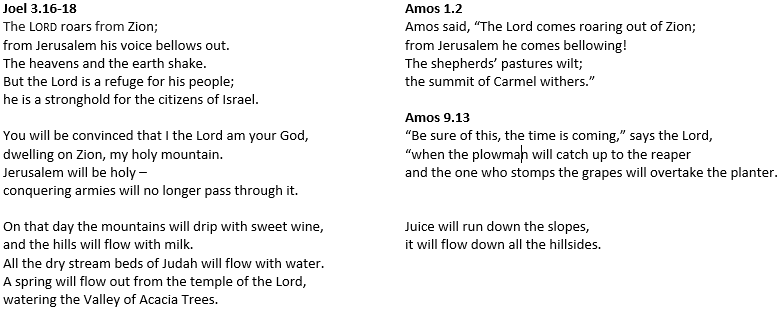By Tyson Thorne

The author of Joel is a literal enigma; we've no information about him except his very common Hebrew name and his father's name, which was either Pethuel (Hebrew manuscripts) or Bethuel (the Septuagint). Joel didn't provide us any clues, either. Most prophets date their prophecy by kings or major historical events, but not Joel/ The few events he does describe — such as a locust plague, are common enough as to be unhelpful. This has caused a great many theories about when the book was written — theories spanning over 200 years of history! 830 BC? 760 BC? 595 BC? No one knows for certain.
Author & Date of Composition
There are three schools of thought in regard to when Joel was written: An early pre-exilic date, a late pre-exilic date, and a post-exilic date. The last of these theories, a post-exilic date, is proposed by liberal theologians who cannot conceive of an all-knowing God capable of communicating future events to His people. They consistently date the prophets after the events they describe for this reason. It is therefore safe to reject this theory out of hand and appropriate to spend the bulk of our time with the two pre-exilic theories.
Early Preexilic Theory. The placement of the book in the canon can be a useful indicator of when a book was written. The Christian canon is ordered in a largely chronological fashion, but this differs from the Jewish order of those same books which are arranged thematically. Since Joel is placed early among the Minor Prophets we know that Christian tradition holds to the early pre-exilic date. The references to Tyre, Sidon, Egypt, Edom and Philistia in the book, instead of Babylon or Assyria would indicate an early date. (Though some have argued that chapter two is a vivid enough description of Babylon that to name them for a contemporary audience is unnecessary.) Also, many of the practices described in Joel were in effect during the ninth century BC.
One of the more interesting arguments is that the message of Amos (known to have been written circa 760 BC) depends upon the people being familiar with Joel’s message. It appears that Amos may have quoted from the final prophecy of Joel at both the beginning and the ending of his book. If true, there are many possible ramifications, including Dr. Benware’s assertion that “Amos took the keynote of his prophecy from the closing word’s of Joel’s prophecy.” Examine the parallel’s below.
Though not conclusive, it is interesting to note how closely these verses parallel each other, especially since Amos records them at the beginning and ending of his book.
Late Preexilic Theory. Essentially, a late pre-exilic date merely moves the book closer to the time of the events it describes happening in “The Day of the Lord.” By moving the date of writing to between 597 and 587 BC the book would fit nicely with other late prophets who refer to the Day of the Lord as the destruction of the temple and Jerusalem in 586 BC. The harmonization of this “Day of the Lord” with the other prophets is what makes this view so attractive. Because so little historic information exists regarding the date of composition, this view is perhaps as likely as the Early Pre-exilic theory. If this dating is correct, Joel would then be no one’s contemporary, a lone prophet of God.
The issue I take with this is that Joel seems to not have a single definition for "The Day of the Lord" like the later prophets do. In fact, he's used the phrase to describe no less than three separate events: a day of judgment for Israel, a day of judgment for Israel's enemies, and the day of judgment at the end of the ages.
Final Analysis. Because of the mention of early enemies of Israel, no mention of Assyria or Babylon, and the possibility of Amos’ quoting of Joel, this author leans toward an early pre-exilic date of composition, while recognizing the complete validity of the Late Pre-exilic theory.
Big Idea
Only Israel’s national repentance can turn “the Day of the Lord” into a time of blessing.
The Book
Scholars suggest that Hosea, Joel, Amos and Obadiah are a set with the book of Joel being the anchor book. A synchronic reading of the Minor Prophets looks at the whole to see if there is a theological rendering of these books together. When one does so it becomes apparent that these four books certainly do. For the ending of the book of Amos contains a prophecy against Edom, and Obadiah (the next book) begins with a prophecy against Edom. This may show an intentionality in the ordering of these books, which are not in chronological order as to when they were written. There are thematic connections as well. In Hosea and Amos the "Day of the Lord" is a terrible reckoning but Joel presents it as a day of hope, so Joel is placed between Hosea and Amos to act as a sort of thematic ballast. Also, the first six books of the 12 Minor Prophets alternate from the Northern to the Southern kingdoms. The end of Joel and beginning of Amos are both about the "Day of the Lord" showing further points of connection. These observations may help us understand why these books are ordered the way they are.
Historical Visitation, chapter 1. Joel’s message was based on two recent natural disasters: a great plague of locusts (verses two through four) and a great drought (verses 15-20). Joel interpreted these actions against the land as judgments of God, and shouted his message to awaken God’s people who slumbered in moral depravity. Joel launches from these two crisis events in chapter one, to a look at two times of great desolation in the future.
Prophetic Revelation,chapters 2-3. The “Day of the Lord” (which, in the great span of history refers to the Tribulation, but in Israel’s history also referred to the Assyrian and Babylonian invasions), was immanent, but the people still had time to repent.

